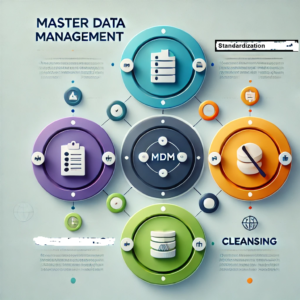New to ERP data management? Start by reading our previous articles on Building a Strong Foundation for ERP Data Management and Achieving Data Quality in ERP to understand how to ensure accurate, reliable data in your ERP system.
From Data Silos to Data Flow: How ERP Integration Builds a Unified Data Landscape
Data integration is essential for ERP systems. It connects disparate data sources, ensuring a unified, seamless flow of information across various business functions. With data integration, companies can bridge the gap between their ERP and other critical systems, such as CRM, SCM, HR, and financial platforms. This connected approach enhances collaboration, reduces data silos, and empowers businesses to make well-informed decisions based on comprehensive data.
In this article, we’ll explore the importance of data integration in ERP, discuss its key components, and offer best practices for creating a unified data environment.
Why Data Integration is Vital for ERP Systems
Data integration allows ERP systems to serve as a single source of truth, eliminating isolated data silos. This unified view helps organizations synchronize operations, increase productivity, and reduce redundancies across departments.
Here’s why it matters:
- Enhanced Decision-Making: Integrated data allows organizations to make faster, data-driven decisions based on complete and accurate information.
- Improved Efficiency: Seamless data flow across departments minimizes manual data entry and reduces errors, enhancing operational efficiency.
- Better Customer Experience: By integrating ERP with CRM and customer support systems, companies gain a 360-degree view of customer interactions, improving service quality and personalization.
- Real-Time Insights: Data integration enables real-time insights into business operations, helping organizations respond quickly to changes in demand, production, or market conditions.
Key Components of ERP Data Integration
1. Middleware
Middleware acts as a bridge between ERP systems and other software, enabling data to flow back and forth without manual intervention. Middleware solutions like MuleSoft, Dell Boomi, and SAP PI/PO help standardize data exchange protocols, ensuring data consistency.
2. APIs (Application Programming Interfaces)
APIs allow different software applications to communicate with each other. Many ERP systems offer built-in APIs for common integrations, making it easier to connect with CRM, HRM, and SCM platforms. Custom APIs can also be developed to meet unique integration requirements.
3. ETL (Extract, Transform, Load)
ETL tools are used to move data from one system to another, transforming it to match the target system’s requirements. ETL processes ensure that data is consistent, clean, and properly formatted, supporting smooth data flow between ERP and other platforms.
4. Real-Time Integration vs. Batch Processing
Real-time integration updates data instantaneously across systems, ensuring immediate data availability, while batch processing updates data at scheduled intervals. Real-time integration is ideal for dynamic operations like inventory or customer service, whereas batch processing works well for financial reporting.
Challenges in ERP Data Integration
1. Data Compatibility Issues
Different systems may use various formats and standards, making it challenging to ensure compatibility. To address this, organizations can standardize data formats or use middleware to convert data as it moves between systems.
Diverse Data Formats: Different systems use various formats and structures.
2. Data Security Concerns
When data is shared between systems, it is essential to protect it from unauthorized access. Security protocols such as data encryption, role-based access controls, and secure API endpoints are necessary to safeguard integrated data.
Security Concerns: Sharing sensitive data increases risks of breaches.
3. Complex System Architecture
Complex architectures involving multiple integrations can make data synchronization challenging. Regular audits, simplified integration paths, and modular integration strategies can help streamline complex setups.
Complex Legacy Systems: Older systems may not support modern integration tools.
4. High Initial Setup Costs
Data integration projects can be resource-intensive, requiring both time and budget. While the initial investment can be high, the long-term efficiencies and insights gained through integration often deliver a strong return on investment.
Data Integration Strategies for ERP Systems
1. Point-to-Point Integration
- Description: Direct integration between two systems or applications.
- Use Case: Suitable for small-scale integrations with limited systems.
- Tools: Dell Boomi, MuleSoft.
2. Middleware Integration
- Description: Middleware acts as a hub, enabling seamless communication across systems.
- Use Case: Ideal for integrating multiple systems.
- Tools: SAP Process Orchestration (SAP PO), Oracle Integration Cloud.
3. API-Driven Integration
- Description: Uses APIs to connect ERP systems with other platforms in real-time.
- Use Case: Suitable for modern, scalable, and flexible integrations.
- Tools: REST APIs, GraphQL, Postman.
4. ETL (Extract, Transform, Load) Integration
- Description: Extracts data from source systems, transforms it, and loads it into ERP.
- Use Case: Useful for batch data transfers and analytics.
- Tools: Informatica, Talend, SAP Data Services.
5. Cloud-Based Integration
- Description: Uses cloud platforms to connect on-premise and cloud ERP systems.
- Use Case: Best for hybrid environments.
- Tools: AWS AppFlow, Microsoft Azure Logic Apps.
Best Practices for Successful ERP Data Integration
1. Prioritize Data Governance
Data governance establishes rules for data consistency, ownership, and quality across integrated systems. By enforcing data governance policies, organizations can ensure that data remains accurate and standardized as it flows across different platforms.
2. Use Scalable Integration Solutions
Choose integration solutions that can scale as your organization grows. Scalable solutions, like cloud-based middleware, offer flexibility, allowing for additional integrations without major reconfigurations.
3. Implement Real-Time Monitoring
Set up real-time monitoring to detect integration issues as they arise. This allows the IT team to resolve problems quickly, minimizing disruptions and maintaining data integrity.
4. Perform Regular Data Synchronization Checks
Regular checks on data synchronization help identify discrepancies early. These checks should include verifying that data fields match in format, accuracy, and completeness across integrated systems.
5. Establish Clear Documentation
Document all integration processes, including configurations, API details, and error-handling protocols. This documentation aids future troubleshooting and ensures consistency across departments.
Examples of ERP Data Integration Use Cases
1. CRM and ERP Integration
Integrating CRM with ERP provides a comprehensive view of customer data. Sales teams can access up-to-date inventory levels from ERP when creating quotes, and customer service can view a customer’s order history in real time, improving the customer experience.
2. Supply Chain and ERP Integration
With ERP and SCM integration, businesses can manage supply chain activities with real-time data on inventory, demand, and supplier status. This helps reduce stockouts and improves planning accuracy.
3. Financial Systems and ERP Integration
Connecting financial systems to ERP supports accurate, timely financial reporting. With integrated systems, financial data flows seamlessly from departments like sales and procurement to finance, enhancing budget tracking and compliance.
Tools for ERP Data Integration
- SAP Cloud Integration
- Facilitates seamless integration of SAP and non-SAP systems.
- Oracle Integration Cloud (OIC)
- Provides pre-built adapters for Oracle ERP integration.
- MuleSoft Anypoint Platform
- Enables API-led integration across various systems.
- Informatica Cloud Data Integration
- Offers advanced features for real-time and batch integrations.
- Dell Boomi
- A versatile platform for integrating ERP systems with other enterprise applications.
Benefits of ERP Data Integration
- Unified View of Operations: Consolidates data for better monitoring and control.
- Improved Efficiency: Reduces manual tasks and eliminates redundant processes.
- Data Accuracy: Minimizes errors through automated data exchange.
- Scalability: Supports the growing needs of an expanding organization.
Conclusion
Data integration is essential for creating a unified data environment that supports seamless business operations and data-driven decision-making. By implementing best practices like prioritizing data governance, using scalable solutions, and performing regular synchronization checks, organizations can overcome integration challenges and fully leverage their ERP’s potential.
Introducing Our YouTube Channel: ERP Data management
Our channel is dedicated to breaking down the complexities of ERP systems like SAP and Oracle Cloud, providing actionable insights and practical knowledge to help businesses and professionals thrive.
From data migration and integration tips to strategies for improving data quality and governance, we cover it all. Whether you’re an ERP expert or just starting your journey, our easy-to-follow tutorials, expert advice, and real-world examples are here to empower you.
Subscribe now and join a community that’s transforming the way businesses manage their data and processes!



One thought on “ERP Data Integration: Unifying Systems for Better Business Intelligence”